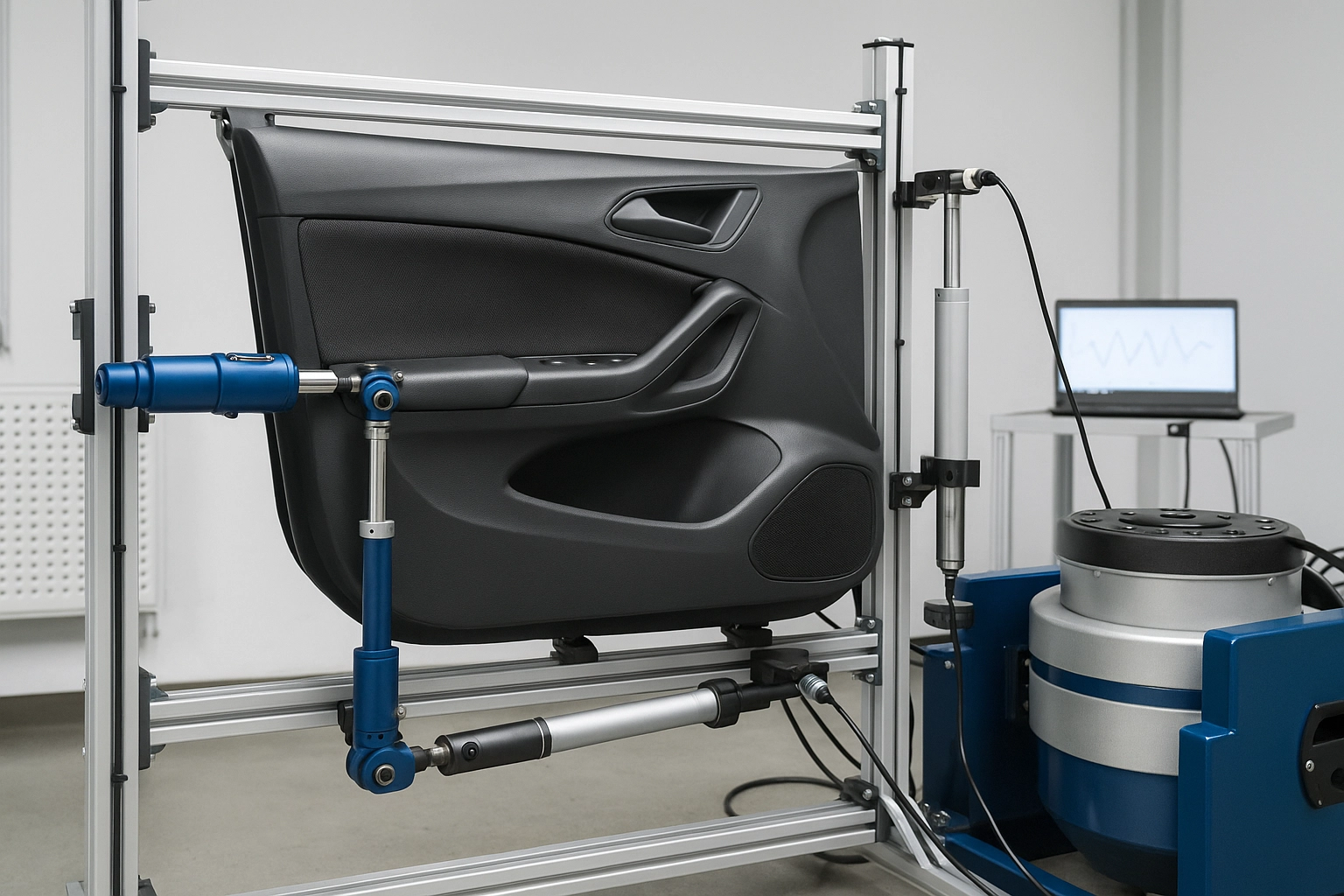DIN 53435 Plastics Vibration BSR Testing
The DIN 53435 standard is a critical component in ensuring that automotive components made from plastics are robust and reliable under dynamic conditions. This test evaluates the ability of plastic parts to withstand vibrations, which can lead to undesirable noises known as "Buzz, Squeak & Rattle" (BSR). Automotive parts such as seats, door panels, and trim require this testing because they must perform consistently in the challenging environmental conditions found within vehicles.
The DIN 53435 test involves placing a specimen under controlled vibration. The goal is to assess how the material behaves over time when subjected to these vibrations, particularly focusing on its ability to prevent noise generation and maintain structural integrity. This testing helps manufacturers identify potential issues early in the design phase, ensuring that products meet stringent quality standards before they reach production.
The standard specifies detailed requirements for the test setup, including the type of vibration exciter used, the frequency range, and the duration of the test. It also outlines specific criteria for evaluating the performance of the specimen based on both visual inspection and listening tests conducted by trained personnel. Compliance with this standard is essential for automotive manufacturers who wish to ensure their products meet international quality benchmarks.
Understanding the importance of BSR testing can help potential clients appreciate why it's crucial for maintaining high-quality standards in the production process. By addressing these issues early on, companies can avoid costly recalls and improve customer satisfaction. The detailed methodology provided by DIN 53435 ensures that all tests are conducted consistently across different manufacturers and locations.
When selecting a laboratory to conduct this type of testing, it's important for clients to consider factors such as the expertise of the staff, the accuracy of equipment used during the test, and the reliability of results obtained. A reputable facility like ours offers comprehensive services tailored specifically towards meeting these stringent requirements while providing detailed reports that are easy to understand yet thorough in their coverage.
For those interested in learning more about how we can assist with DIN 53435 testing for plastics, please contact us directly so we may discuss your particular needs. Our team of experts will provide valuable insights into the process and help guide you through every step of the way.
Why It Matters
The quality and performance of automotive components are directly impacted by their ability to withstand vibrations during use. Buzz, Squeak & Rattle (BSR) testing is essential in ensuring that these elements do not contribute towards unwanted noises or rattles within the vehicle. By addressing potential issues early on through rigorous testing processes like DIN 53435, manufacturers can significantly enhance both the functionality and customer satisfaction associated with their products.
The standard focuses on evaluating how plastic materials behave when exposed to vibrations over extended periods. This includes assessing whether any noise or rattling occurs due to poor design choices or material selection. The results from BSR tests provide valuable information that can be used by engineers during the product development phase, helping them make informed decisions about improvements needed before mass production begins.
Compliance with DIN 53435 not only enhances a company’s reputation but also contributes positively towards environmental sustainability efforts. By reducing BSR-related complaints from customers and minimizing waste associated with faulty parts being returned for replacement, firms demonstrate their commitment to sustainable practices throughout the entire lifecycle of their products.
Benefits
- Improved Product Quality: Ensures that all automotive components meet high-quality standards by identifying and rectifying any defects early in the manufacturing process.
- Enhanced Customer Satisfaction: By minimizing BSR-related problems, manufacturers can improve overall driving experiences for consumers, leading to greater customer loyalty.
- Risk Management: Reduces the likelihood of recalls and associated costs by catching potential issues before they become widespread.
Scope and Methodology
The DIN 53435 standard specifies a range of procedures designed to evaluate the resistance of plastic materials used in automotive applications against vibrations. The testing procedure involves placing a specimen under controlled vibration conditions, typically using a shaker system capable of generating frequencies within the range specified by the standard.
During the test, engineers monitor various parameters including displacement, acceleration, and force applied to the specimen. Visual inspections are also conducted periodically throughout the duration of the test to observe any changes in appearance or structural integrity that might indicate failure. Additionally, listening tests may be performed by trained personnel who evaluate whether there is any audible noise being generated from the specimen.
After completing the prescribed period of vibration exposure, the specimen undergoes further examination to assess its overall condition. Any discrepancies noted during this phase are documented and reported back to the manufacturer for analysis. Based on these findings, corrective actions can then be implemented if necessary.
The DIN 53435 standard also provides guidelines regarding sample preparation, environmental controls, and reporting formats used in documenting results. These provisions ensure consistency across different laboratories performing similar tests, thereby facilitating accurate comparisons between various specimens tested according to the same criteria.





